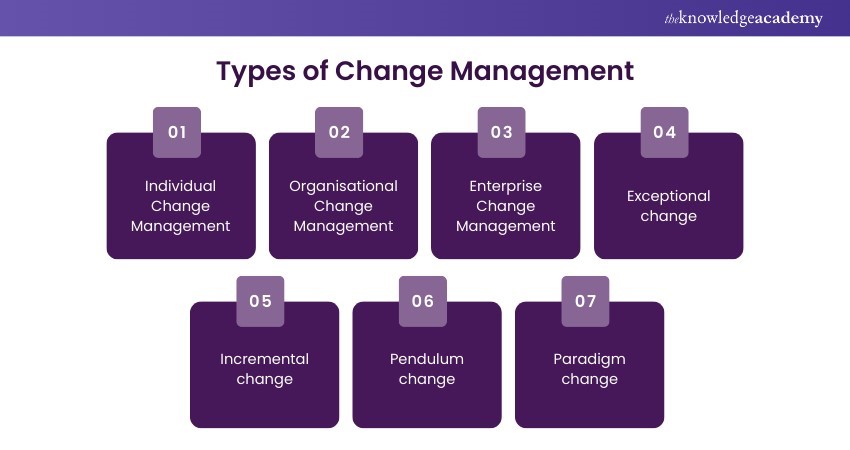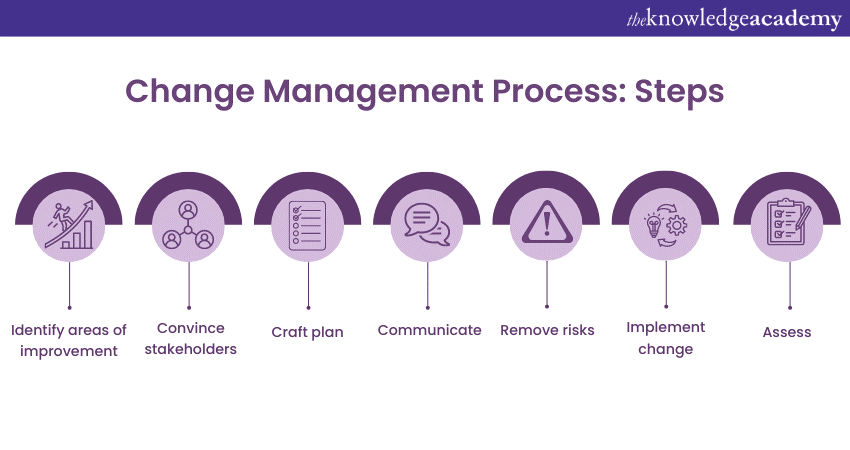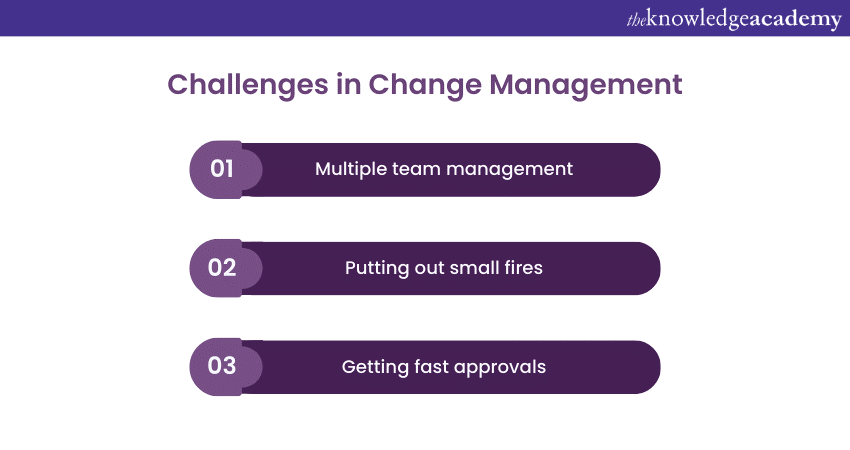We may not have the course you’re looking for. If you enquire or give us a call on 01344203999 and speak to our training experts, we may still be able to help with your training requirements.
Training Outcomes Within Your Budget!
We ensure quality, budget-alignment, and timely delivery by our expert instructors.

In a world where new businesses emerge almost daily, it is imperative to stay unique and establish itself as the best among rivals. One way is by introducing changes in management processes, upgrading to better technology and aligning business practices with the latest trends. Introducing such changes to organisations and helping employees understand them is known as the Change Management process. It should be noted that change management principles is the building block for change management process. If you are someone new to this topic, we will help you understand various processes required to implement change within the organisation. This blog explains what a Change Management Process is and its steps like preparation, planning, and implementation, and more. Read ahead to learn more!
Table of Contents
1) Change Management- An overview
2) What is Change Management Process?
3) What are the steps in Change Management Process?
4) Why do you need an effective Change Management Process in your organisation?
5) Conclusion
Change Management – An Overview
Change Management refers to the effective management of changes being implemented in an organisation and effectively using these changes to bring favourable business results. Before explaining more about the Change Management Process, it is essential to know about the two types of organisational changes possible, They are mentioned below:
a) Adaptive changes: These are small-scale organisational changes whose results spring up over a prolonged period. These changes can be implemented to improve workflow, business strategies, and even products.
b) Transformational changes: Large-scale changes that can cause a significant ripple within the organisation are known as transformational changes. For instance, if a company decides to open a new branch or expand to other countries, it constitutes a transformational change. Although most businesses benefit from organisational changes, other types of changes can also work better. The following are some common categories of Change Management:

a) Individual Change Management: This type of Change Management appeals to influencing the mindset and emotions of your employees, to manage them better.
b) Organisational Change Management: Organisational change management refers to the processes that bring changes to the workplace. This could include changes in product development processes or workflow.
c) Enterprise Change Management: This is the biggest level of the Change Management as it affects every sector of the organisation including the individuals in leadership positions, the pivotal processes, procedures, etc.
d) Exceptional change: Exceptional changes are instances where necessary improvements occur as isolated events. They only impact those directly involved, although the scale varies based on the magnitude of the change.
e) Incremental change: Incremental changes are implemented over time to avoid sudden shifts. One common example of this Change Management type is updating existing technology with newer models. Instead of waiting for technology to become outdated, regular updates can enhance employee learning and training by incorporating tools they are already familiar with.
f) Pendulum change: A pendulum change occurs when your organisation shifts drastically from one state to its opposite, like a pendulum swinging. This was evident in numerous organisations during the initial stages of the COVID-19 pandemic when they transitioned from in-person, on-site work to fully remote and virtual settings. This change management instance involves effectively managing and adapting to this shift in direction and goals.
g) Paradigm change: A paradigm shift happens when your company embraces new beliefs. These initiatives involve aligning processes and policies with the newly established core values across different organisational levels. While some changes may be widespread, others might be specific to certain teams.

What is Change Management Process?
The Change Management Process outlines the steps involved in implementing a Change Management strategy. It helps organisations get used to new things and reach their goals. This Process includes the following:
1) Get ready for change: Know why and how change will affect you and others.
2) Plan for change: Decide what you want to change and how you will do it.
3) Do the change: Follow your plan and check how it is going.
4) Help others with change: Tell and teach others about the change and what they need to do.
5) Keep the change: See if the change worked and make it part of your normal way of doing things.
It It is important because it helps organisations deal with all the aspects of change. For example, imagine you want to use a new technology in your business. Here, you need to think about how it will affect your staff, structure, budget, training, and so on. It helps you make changes smoothly and successfully.
What are the Steps in Change Management Process?

There are several factors to consider before introducing any change to an organisation. Let's look at these factors in detail as we take you through a comprehensive guide to introduce changes to an organisation smoothly:
Identify areas of improvement
One of the biggest challenges of introducing a change to a business is deciding the area that requires one. There might be a need to implement multiple changes. However, you must narrow down and implement the ones that seem the most important and can fit into your company budget
You must first identify the aspect of the organisation you wish to improve, like a process or the general workflow. Then, list the resources or individuals that can help improve it. A clear vision of what to improve provides a higher chance for a successful implementation of change.
Convince the stakeholders
Getting the stakeholders on board with the plan to implement changes is a crucial step in the Change Management Process. This is because they handle essential aspects of the business and are responsible for funding future organisational changes.
The panel of stakeholders include a wide range of personalities, each with different priorities. Therefore, it is crucial to present a detailed pitch to them, catering to each of their concerns. Additionally, it is important to list the benefits of welcoming that change to the company.
Craft a detailed plan
The next step is to create an elaborate plan for introducing and implementing the change. The Change Management plan must contain all the details ranging from long-term organisation goals to project scope. The four key points to always mention in your change management plan are as follows:
1) Organisational goals: The plan must mention the goals that the change(s) can now help the organisation work toward and the processes to do so.
2) Key Performance Indicators (KPIs): It is essential to determine the factors that are used to measure the extent of success of the newly implemented change. Any changes in the current metrics and the period of assessment must also be mentioned.
3) Assigned stakeholders and team members: The stakeholders overseeing the change implementation process must be mentioned in the plan alongside the team leaders and members responsible for carrying out the processes.
4) Project capacity: One of the most significant points to add to the plan is the capacity of the project. This includes the processes that will be used to implement the change and to determine what fits and doesn't in the capacity of the project.
Acquire the skills to drive successful change initiatives in organisations – join our Change Management Foundation & Practitioner Training today!
Convey the vision to everyone
Once the plan is made, the next important step is communicating the vision to everyone in the organisation. Implementing a change can affect the psyche of the employees and bring a rift in the company culture.
A sudden change without warning can have a devastating effect on the company and its employees. Often, employees might resort to the previous work structure as well. Thus, it is vital to familiarise everyone with the new changes, their objectives, the areas that will change the most, and ways to handle the change effectively.
Every team of the organisation must be made aware of the changes. Any inconsistency in communication can result in certain team members working with outdated or discarded procedures, causing more confusion and chaos.
The changes must be incorporated into the company's culture to establish their importance and keep employees from resorting to outdated processes. Updated documents must be distributed to everyone so that all are aware and on board with the change.
Anticipate and mitigate risks
There will be multiple roadblocks which must be identified before implementing the change. One of the biggest challenges one might encounter is employee resistance. Everyone doesn't need to adapt quickly, as humans are bound to react to any kind of change. This explains the importance of having everyone on board with the plan, as mentioned above.
Other potential risks are centred around deciding whether the change will bring new equipment to the organisation. If yes, that would that lead to discarding the old ones? Identifying and solving these potential roadblocks is essential for a smooth implementation of changes.
Applying the change
The implementation of the change is the most essential part of the process. This stage involves following the detailed roadmap created beforehand to bring change to the company's structure or strategy. It depends on the area where the change is introduced.
The change can be directed to the company's overall goals, employees, systems, etc. Therefore, the team leaders are responsible for motivating their team members to perform the tasks required to implement the change effectively. This also includes narrowing down possible risks and removing them. Some of the most commonly faced challenges while implementing changes in organisations are as follows:

a) Multiple team management: When new changes are introduced to an organisation, additional teams will be created. This is to ensure that the changes are being implemented the right way. As the number of teams increases, their management also becomes a hassle. Using Change Management software can help all members stay updated about the situation. It also helps the upper management to supervise multiple teams easily.
b) Putting out small fires: Sometimes, when one sector of your business improves, it can negatively affect other areas. Therefore, it is essential to map out the required changes in detail and follow a pattern with minimum interference with the functionality of the remaining sectors.
c) Getting fast approvals: Time is another common challenge faced during a Change Management Process. When new changes are introduced, there might be a shift to new technology or new systems and operating them would require approvals. The systems are either checked by internal or external personnel, and approvals generally take longer to come from external workers. An efficient workflow can benefit the organisation in such situations.
d) Communication breakdown: It is important to keep communicating and updating how things are done in your organisation. Everyone on the team must know what's going on right away, and everyone should be able to see the latest documents to ensure all have the same information.
e) Employee resistance: Sometimes, your employees might not like the changes you are making, and it is nothing personal. Humans are naturally hesitant to accept change. There are six stages of how they might feel: indifference, rejection, doubt, neutrality, experimentation, and commitment. Check where your employees are in this process and give them time to get used to the changes.
f) Correcting faulty change systems: It is important to follow the guidelines closely when making changes, but sometimes, things don't turn out as expected. In this situation, we can't go back to how things were before as we have already changed them. Therefore, we need a good plan for changing things and a tool to keep everything organised.
Unlock your organisation's potential with our Change Management Foundation Course - embrace change, drive success!
Assess and improve
Once the changes have been implemented, the next step is to ensure they are effective and keep track of their progress. The KPIs mentioned in the Change Management plan help assess the changes' performance.
A detailed analysis can reveal the status of the business after changes were introduced. The current standpoint of the organisation can help stakeholders and business leaders understand the effectiveness of the change. The evaluation results can help them determine whether or not to invest in more of the changes.
Why do you need an effective Change Management Process in your organisation?
Having an effective change management process is crucial for any organisation as it helps manage people and prevent accidents. It also improves asset reliability, tracks changes, and evaluates alternatives. Employees play a big role in the success of any project, so their acceptance or rejection of changes can make a big difference. Sometimes, people are afraid of changes and prefer sticking to what they know. Thus, it's important to involve everyone in the change process and communicate why the changes are happening. This way, employees understand the reasons behind the changes and are more likely to support them willingly.
Unlock the power of Change Management – join our Complete Change Management Assessments Training today and be the catalyst for transformation!
Conclusion
Recognising when change is necessary and implementing it at the right time is significant for business success. That's why organisations adopt the Change Management Process. They are a list of activities designed to help businesses smoothly adapt to new changes. We hope you gained insight into these Processes, different steps and types and their importance in an organisation.
Wish to know more about change management? Sign up for our Change Management Practitioner course now!
Frequently Asked Questions

Change Management is important for business firms. This is because it helps minimise disruptions and enhances employee morale and productivity. It provides a framework for managing resistance, addressing concerns, and guiding stakeholders through the complexities of organisational change.

There are several key components. This includes identifying the need for change, developing a clear vision and strategy, communicating effectively, providing support, and evaluating progress. These elements ensure a systematic approach to change, fostering resilience and increasing the chances of achieving desired results.

The Knowledge Academy offers various Change Management Certification Courses, including Change Management Foundation, Practitioner, and Risk Management for Change Training. These courses cater to different skill levels, providing comprehensive insights into Change Management skills.
Our Project Management blogs covers a range of topics related to Change Management, offering valuable resources, best practices, and industry insights. Whether you are a beginner or looking to advance your Change Management skills, The Knowledge Academy's diverse courses and informative blogs have you covered.

The Knowledge Academy’s Knowledge Pass, a prepaid voucher, adds another layer of flexibility, allowing course bookings over a 12-month period. Join us on a journey where education knows no bounds.

The Knowledge Academy takes global learning to new heights, offering over 30,000 online courses across 490+ locations in 220 countries. This expansive reach ensures accessibility and convenience for learners worldwide.
Alongside our diverse Online Course Catalogue, encompassing 17 major categories, we go the extra mile by providing a plethora of free educational Online Resources like News updates, Blogs, videos, webinars, and interview questions. Tailoring learning experiences further, professionals can maximise value with customisable Course Bundles of TKA.
Upcoming Project Management Resources Batches & Dates
Date
 Change Management Foundation
Change Management Foundation
Sat 11th May 2024
Mon 13th May 2024
Mon 20th May 2024
Mon 3rd Jun 2024
Sat 8th Jun 2024
Mon 17th Jun 2024
Mon 1st Jul 2024
Sat 6th Jul 2024
Mon 15th Jul 2024
Mon 29th Jul 2024
Mon 12th Aug 2024
Sat 17th Aug 2024
Tue 27th Aug 2024
Mon 9th Sep 2024
Sat 14th Sep 2024
Mon 23rd Sep 2024
Mon 7th Oct 2024
Sat 12th Oct 2024
Mon 21st Oct 2024
Mon 28th Oct 2024
Mon 4th Nov 2024
Sat 9th Nov 2024
Mon 11th Nov 2024
Mon 18th Nov 2024
Mon 25th Nov 2024
Mon 2nd Dec 2024
Sat 7th Dec 2024
Mon 9th Dec 2024
Mon 16th Dec 2024







 Top Rated Course
Top Rated Course


 If you wish to make any changes to your course, please
If you wish to make any changes to your course, please


